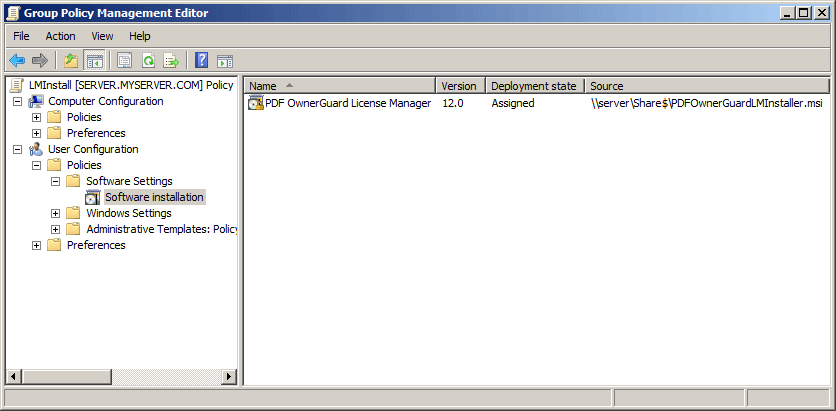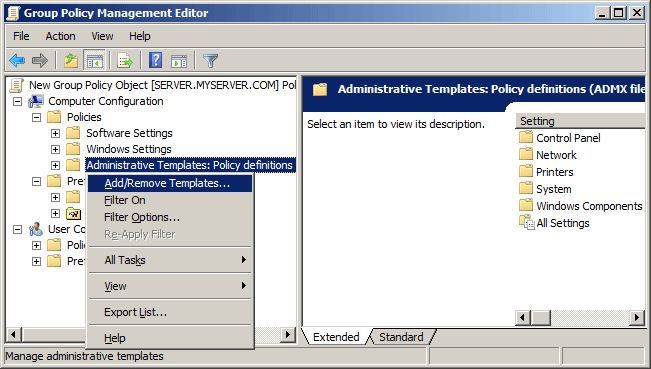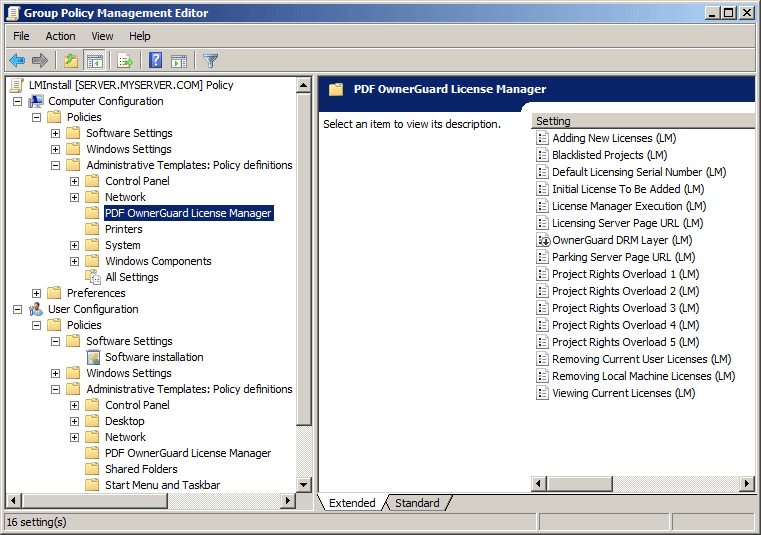Automatic Deployment, Licensing and Central Rights Management
In large scales, deploying license manager, managing users and licenses can be a huge headache for administrators even using Automated Licensing Method and Serial Numbers. In organizations with great amount of computers and users there’s a serious need for a fully automated deployment, licensing and central management of groups, users and rights.
As an owner or seller of protected contents, you may also face situations in which you need to authorize hundreds of clients in destination organization to access your protected files with minimum administrative efforts. As you’ll see in this page, this can be simply done by preparing a customized License Manager MSI installer and automatic deployment using Windows Group Policy features.
Table Of Contents
1 – Preparing Licensing Serial Numbers
2 – Configuring License Manager MSI Installer
3 – Automatic Deployment of License Manager
4 – Managing Rights Using OwnerGuard Group Policy Template
1 – Preparing Licensing Serial Numbers:
For licensing phase we use a serial number to add required license(s) to target groups, users or computers. For more info about creating serial numbers and automated licensing and you can visit: Automated Licensing
2 – Configuring License Manager MSI Installer:
For automatic license manager deployment using Windows Group Policy, you need to configure the License Manager MSI Installer file you’ve received as a part of your Enterprise Server Package. For this purpose you need to use License Manager MSI Customizer program installed as a part of Enterprise Server package.
![]()
We’ll describe the settings related to automatic deployment and licensing.
Licensing Server Page URL:
Licensing server page address used by license manager to send required info and receive license.
Parking Server Page URL:
Parking server page address used for license parking feature.
Default Serial Number:
This serial number can be used to auto-fill the Serial Number field in License Manager GUI upon execution by user.
License Manager Arguments:
After successful deployment, license manager executable file will be automatically executed passing the arguments specified in this field. We can use this arguments field to specify licensing details.
Specifying the Serial Number:
To add license(s) to target users or computers, we use serial numbers. There are different options to specify the serial number you want to be added after successful deployment.
Using ‘/addserial <SERIAL NUMBER>’:
You can use /addserial followed by a fixed predefined serial number. In this case license manager will use this serial number to add licenses to all targets. This method is also suitable for external license distribution. For example if you need to authorize maximum 500 computers or users in destination organization to access your protected files, you can create a single serial number with ‘Number of Licenses’ field set to 500 and specify this serial number in your msi installer. You can then deliver the configured msi installer to the destination organization administrator for Automatic Deployment on target groups, users or computers using Windows Group Policy feature.
Using ‘/addserial gpserial’:
Using this command you specify that license manager must use the serial number defined in OwnerGuard Group Policy Template for the target user, group or computer in ‘Default Licensing Serial Number’ policy setting. This way you can use different manageable serial numbers with different rights for different users or groups. We’ll discuss more about OwnerGuard Group Policy Template later in this article.
Specifying License Scope:
By default, licenses will be added to Local Machine meaning that every user of the target computer will be able to access the added licenses and the related protected files. Using /addtocu switch you can specify that the related license must be added to Current User instead of Local Computer. In this case, the added license and related protected files will be accessible only for specific user.
3 – Automatic Deployment of License Manager:
You’re now ready to deploy license manager msi installer using Windows Group Policy. For more info about how to deploy msi packages using windows 2003/2008 server group policy you can visit this article
 .
.
After successful deployment, license manager will be installed and the desired license(s) will be added to target groups, users or computers. As a result, related protected files will become accessible on targets, based on predefined limitations define in serial numbers.
4 – Managing Rights Using OwnerGuard Group Policy Template:
You can manage drm rights and define License Manager Policies for active directory user, computer and groups using OwnerGuard Group Policy Administrative Template. Using this feature you can change permissions or revoke access to protected files for desired active directory users anytime needed. Policy Templates are available for Computers and Users.
To add OwnerGuard Group Policy Template to your GPO, you can use the provided ADM or ADMX file you’ve received as a part of Enterprise Server Package by copying ADMX file and related folder to Windows\PolicyDefinitions folder or by using ‘Add/Remove Templates…’ feature and selecting the ADM file.

After adding the template, OwnerGuard License Manager policy settings will be available in Administrative Templates section (using ADMX template) or in Classic Administrative Templates (using ADM template).

Default Licensing Serial Number:
Using this policy setting you can specify a serial number to be used for adding required licenses during automatic deployment.
License Revocation:
You can revoke specific project licenses anytime needed by adding the project name to blacklist using ‘Blacklisted Projects’ section.
Changing Permissions:
You may change users, groups or computers rights accessing specific project files by using ‘Project Rights Overload’ policy.
This policy setting allows you to change(increase) the limitations of a specific project license which is already added to user/computer or will be added in future. You can use maximum rights in your license for all clients and use this policy to manage desired limitations using Group Policy.

License Manager Usage Rights:
You may also manage rights for users in working with License Manager program.
License Manager Execution: Allow or disallow execution of License Manager by user.
Adding New Licenses: Enable or disable the ability to add new licenses using License Manager.
Viewing Current Licenses: Enable or disable the ability to view currently available licenses by user using License Manager.
Removing Current User License: Allow or disallow removing Current User Licenses using license manager program.
Removing Local Machine License: Enable or disable removing Local Machine Licenses using license manager program.
